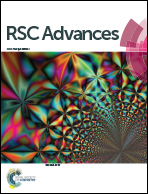Limited Ce doped Ni–Co as a highly efficient catalyst for H2-SCR of NO with good resistance to SO2 and H2O at low temperature
Abstract
The Ni1−xCexCo1.95Pd0.05O4 catalysts doped with limited Ce were fabricated using a sol–gel method and employed to investigate the SO2-resistance in the selective catalytic reduction of NO by hydrogen (H2-SCR). The results indicated that the inclusion of a limited amount of cerium not only effectively enhanced the catalytic activity of Ni1−xCexCo1.95Pd0.05O4 catalysts but also improved their resistance to SO2. Notably, when the Ce doping was 0.07 at%, the catalyst showed high sulfur resistance and exhibited a broader temperature window of 140–350 °C with a maximum NOX conversion of 98% at 190 °C. Also, addition of 5% H2O into the feed gas slightly decreased the deNOX performance of all catalysts, the NOX conversion nearly recovered to the initial level with H2O withdrawal, and the resistance to H2O also increased gradually in correspondence to the increase in Ce doping. Meanwhile, an increase of GHSV from 4800 to 9600 mL h−1 g−1, the NO/H2 ratios from 1 : 10 to 1 : 1 and the O2 content from 0% to 6%, gradually decreased the removal efficiency of NO. The XPD and XRS analysis depicted fine cubic spinel-type structures and Ce bearing two chemical valence states doped in the spinels. In the H2-TPR and NH3-TPD analysis, the Ce doping resulted in the temperature shift of reductive peaks and weak acid sites to lower temperature and the increase of strong acid sites. These results enhanced the redox property and led to a positive effect on SCR reaction, which were consistent with the SCR activity data.


 Please wait while we load your content...
Please wait while we load your content...